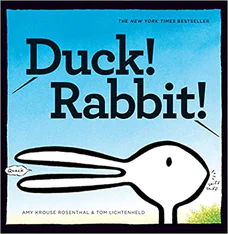Duck! Rabbit!
Written by Amy Krouse Rosenthal
Illustrated by Tom Lichtenheld
40 pages
•
Published 2009 (Chronicle Books)

Recommended Age Range: Preschool through 3rd grade. It comes in a board book as well as hard- and softcover, but the cognitive skill required to really appreciate this book doesn’t develop for most children until around age 4.
Publisher's Summary:
A clever take on the age-old optical illusion: is it a duck or a rabbit? Depends on how you look at it! Readers will find more than just Amy Krouse Rosenthal’s signature humor here; there’s also a subtle lesson for kids who don’t know when to let go of an argument.

Dr. Annie's Takeaways
Recommended for: This simple, yet profound story based on the classic rabbit-duck illusion
introduces the idea that two different perspectives can both be true at the same time. It’s great for children who tend to get stuck in arguments about the “correct” perspective (e.g., whether a sibling was being annoying or not) or opinion (e.g., which is the best food, sport, music, etc.).
Would a child like it? Yes. Children who are new to the rabbit-duck illusion will particularly enjoy this book. Many children are fascinated by optical illusions, and this one is a very fun one!
Evidence-Based Practices:
Cognitive Restructuring
Tone: Matter-of-fact, dryly funny
Story Quality: This story introduces kids to the classic rabbit-duck illusion
and through spare dialogue, shows how two different perspectives can both be true at the same time. It’s a fantastic way to introduce this concept without being preachy.
Illustrations: The illustrations are primarily a black-and-white rendition of the rabbit-duck illusion, with some background color (e.g., sky, water).
Representation: We see the speech of two off-page characters having an argument about whether the animal is a duck or a rabbit, but we never see the characters themselves. He/him pronouns are used to refer to the duck/rabbit.
Psychological Practices: This story of two characters arguing about whose perspective is correct (“See, there’s his bill.” “What are you talking about? Those are ears, silly.”) is both funny and profound. It introduces in a very concrete way the idea that two different perspectives can coexist at the same time and that neither is more correct than the other. Being able to refer to a situation as a “duck-rabbit” problem is really useful when children (and/or adults!) are stuck arguing about whose perspective is correct.
Concerns: The two off-page characters don’t model perfect communication skills when debating whether the animal is a duck or a rabbit. I’m sure this is intentional; they’re arguing and we’re meant to see that their argument is futile. The slight roughness also adds to the authenticity and humor. But I wanted to mention that the book does very slightly glamourize arguing–the book is fun, and a child may want to join in to argue for their perspective.
